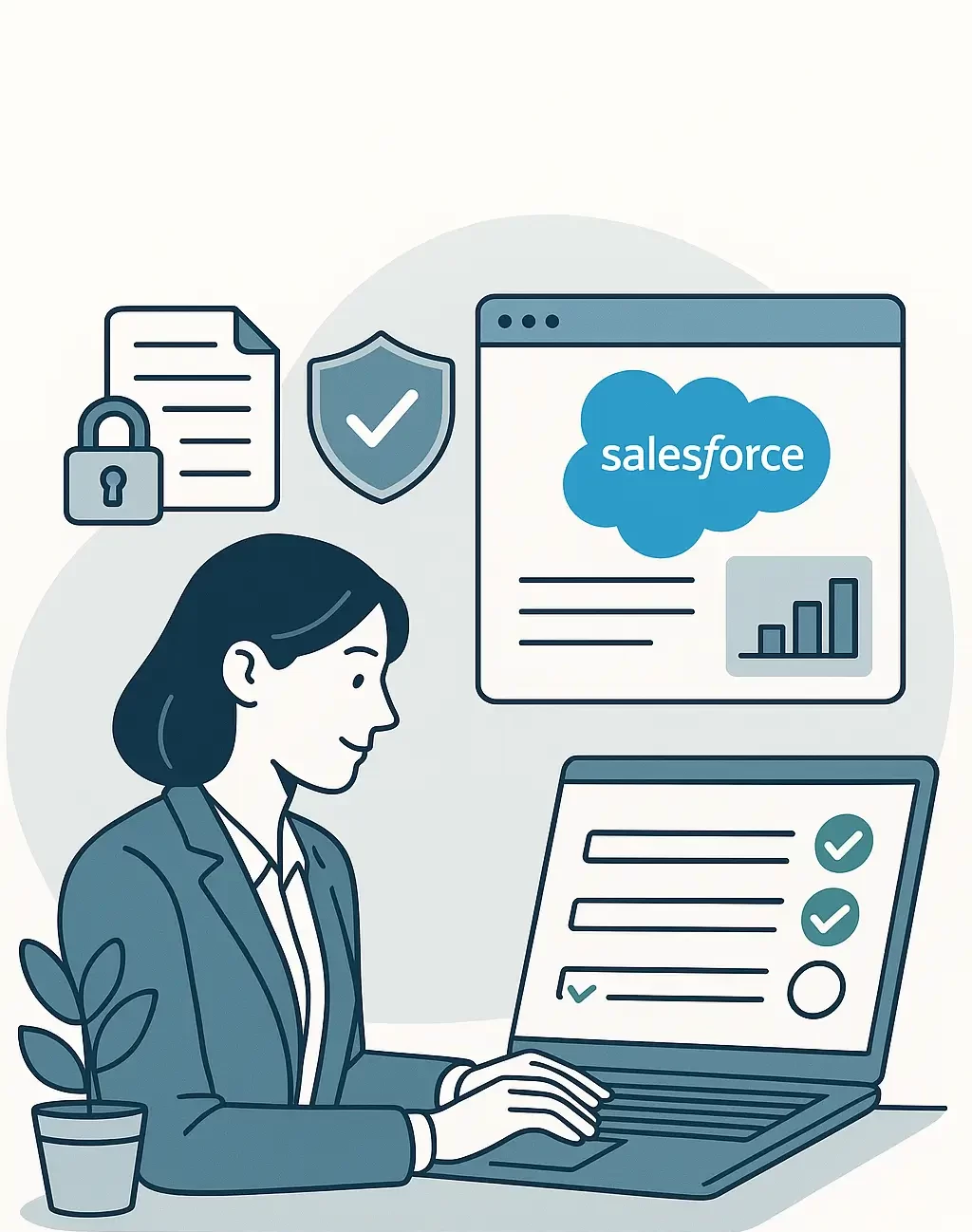Here’s something that might surprise you: customers who have effortless experiences are more likely to stick around than those who are simply satisfied.
While satisfaction feels good in the moment, effort reduction creates lasting loyalty that directly impacts your bottom line.
Customer Effort Score (CES) measures exactly that—how easy or difficult it is for customers to interact with your business. Whether they’re resolving a support issue, making a purchase, or navigating your website, CES captures the friction they experience along the way.
If you’re using Salesforce, you’ll need to determine the best ways to make CES your greatest asset.
Learn how to leverage customer effort scores using Salesforce integrated software.
What is the Customer Effort Score?
Customer Effort Score is a single-item metric that measures how much effort customers need during specific interactions with your company.
Unlike other metrics that focus on emotions or future behavior, CES zeroes in on the practical reality of getting things done.
The beauty of CES lies in its simplicity and direct connection to customer loyalty. Research consistently shows that customers who experience low-effort interactions are significantly more likely to remain loyal, while high-effort experiences drive them straight to your competitors.
How CES Score Differs from Other Metrics
CES occupies a unique space in customer experience measurement. When comparing CES with other customer experience metrics, it’s important to understand that each serves a distinct purpose.
CES vs NPS: NPS asks “Would you recommend us?” while CES asks “Was this easy?” One looks forward, the other examines the immediate experience.
CES vs CSAT: Understanding CSAT as a complementary metric to CES reveals that satisfaction measures emotional response to an interaction, but CES focuses purely on operational ease. You can have a satisfied customer who still found the process unnecessarily complicated.
Deploy CES immediately after specific interactions, use CSAT surveys for broader experience evaluation, and leverage NPS for long-term loyalty tracking.
How to Calculate CES Score
CES Score Calculation Methods
Calculating CES depends on which approach best fits your organization’s needs. The most common method involves averaging responses on a scale, typically ranging from 1-5 or 1-7.
Average Score Method: Add all responses and divide by the number of respondents. If 100 customers rate their experience and the total is 450 points on a 5-point scale, your CES is 4.5.
Percentage Method: Calculate the percentage of customers who gave positive responses (usually the top 2-3 ratings). This approach focuses on the proportion of customers who found the interaction genuinely easy.
Best CES Survey Questions
CES Question Examples
The way you phrase CES questions dramatically affects response quality and accuracy. Following best practices for CES questionnaire design means avoiding the word “effort” directly—it can confuse respondents and lead to inconsistent interpretations.
Recommended phrasing: “[Company] made it easy for me to handle my issue” works better than “How much effort did you need to exert?” The positive framing creates clarity and reduces cognitive load for respondents.
Channel-specific variations:
- Post-support: “The support team made it easy to resolve my issue”
- Post-purchase: “It was easy to complete my purchase”
- Post-onboarding: “Getting started with [product] was straightforward”
When to Send CES Surveys
Timing is everything with CES surveys. Send them immediately after the interaction while the experience is fresh—ideally within 24 hours.
Key touchpoints for CES measurement:
- After support ticket resolution
- Following product returns or exchanges
- Post-onboarding completion
- After account changes or updates
Avoid survey fatigue by being strategic about frequency. One CES survey per customer per month is generally the maximum, unless they’re engaging with different departments or services.
7 Ways to Improve Your CES Score
1. Streamline Support Processes
Reduce handoffs between departments by empowering front-line staff to resolve more issues independently. Every transfer increases effort and frustration, even when handled professionally.
Implement self-service options that actually work. Knowledge bases, FAQ sections, and automated troubleshooting tools can resolve common issues without human intervention.
2. Optimize Digital Experiences
Simplify website navigation by reducing the number of clicks needed to complete common tasks. If customers can’t find what they need within three clicks, you’re creating unnecessary effort.
Ensure mobile responsiveness across all touchpoints. More customers interact with businesses through mobile devices, and clunky mobile experiences create immediate friction.
3. Train Staff for Efficiency
Focus training on first-contact resolution rather than just customer service skills. Empower representatives to make decisions and resolve issues without escalation whenever possible.
Provide staff with the tools and authority they need to solve problems quickly. Nothing frustrates customers more than hearing “I need to check with my manager” for routine requests.
4. Use Automation Strategically
Deploy automated CES surveys in Salesforce for common, straightforward issues while ensuring easy escalation to human agents when needed. Automation should reduce effort, not create new obstacles.
Automate follow-up processes to keep customers informed about progress without requiring them to check in repeatedly. Proactive communication reduces perceived effort significantly.
5. Close the Feedback Loop
Follow up with customers who report high-effort experiences to understand what went wrong and how you can improve. Analyzing CES survey responses effectively shows you value their input and helps prevent similar issues.
Address systemic issues quickly rather than treating each complaint as an isolated incident. Look for patterns in CES feedback that indicate broader operational problems.
6. Integrate CES with Other Metrics
Combine CES data with NPS and CSAT scores to get a complete picture of customer experience. Implementing NPS alongside CES might reveal that customers appreciate your service despite process inefficiencies.
Cross-reference CES scores with customer behavior data to understand the business impact of effort reduction. High-effort customers often reduce their engagement or spending over time.
7. Monitor Trends Over Time
Establish internal benchmarks based on your own historical data rather than relying solely on industry averages. Your improvement trajectory matters more than how you compare to competitors.
Track CES improvements consistently using tracking CES improvements through CRM integration to measure the impact of process changes and investments. Regular monitoring helps you catch problems before they become widespread issues.
How to Integrate CES Score with Your Customer Experience Strategy
Building a Feedback System That Works
Connect CES measurement to your existing Salesforce workflows so insights automatically trigger appropriate responses. When a customer reports high effort, your team should know immediately and have clear next steps.
Cross-departmental collaboration ensures CES insights reach the teams who can actually address the underlying issues. Marketing, product, and operations all play roles in effort reduction.
Real-time response capabilities turn CES from a measurement tool into an active customer recovery system. Quick follow-up on negative scores can often salvage relationships and prevent churn.
Using CES Data to Drive Action
Identify friction points by looking for patterns in low CES scores across different touchpoints. Common themes often reveal systemic issues that require process changes rather than individual fixes.
Prioritize improvement initiatives based on both CES impact and implementation feasibility. Quick wins build momentum while longer-term projects address fundamental friction sources.
Your digital customer experience strategy should incorporate CES measurement as a core component. Measure the impact of changes by tracking CES scores before and after process improvements.
Ready to Reduce Customer Effort?
CES measurement transforms how organizations think about customer experience by focusing on practical friction rather than emotional satisfaction. The customers who stick around aren’t necessarily the happiest—they’re the ones who can get things done easily.
Successful CES implementation requires the right tools, proper timing, and commitment to acting on insights. When feedback flows seamlessly into your existing processes, effort reduction becomes part of your operational DNA rather than a separate initiative.
SurveyVista’s native Salesforce integration makes CES tracking as effortless for your team as you want the experience to be for your customers. Your feedback system should reduce effort, not create it.
Frequently Asked Questions
What’s the difference between CES and customer satisfaction scores?
CES measures how easy an interaction was, while satisfaction measures emotional response. You can have satisfied customers who still find your process complicated. CES focuses on operational friction, satisfaction focuses on feelings about the outcome.
When should I send CES surveys to get accurate responses?
Send CES surveys immediately after the interaction, ideally within 24 hours while the experience is fresh. Target specific touchpoints like support resolution, purchases, or onboarding completion rather than general relationship surveys.
What’s considered a good CES score?
On a 1-7 scale, 70% or higher positive responses typically indicate good performance. However, your internal trends matter more than industry benchmarks. Focus on consistent improvement over time rather than comparing to competitors.
How often should I survey customers with CES?
Limit CES surveys to once per customer per month to avoid survey fatigue, unless they’re interacting with different departments. Quality responses matter more than frequency—strategic timing beats constant surveying.
Can I use CES alongside NPS and CSAT surveys?
Yes, combining all three metrics provides a complete customer experience picture. Use CES for immediate interaction feedback, CSAT for broader experience evaluation, and NPS for long-term loyalty tracking. Each serves different purposes.
More Like This

Rajesh Unadkat 
Founder and CEO
Rajesh is the visionary leader at the helm of SurveyVista. With a profound vision for the transformative potential of survey solutions, he founded the company in 2020. Rajesh's unwavering commitment to harnessing the power of data-driven insights has led to SurveyVista's rapid evolution as an industry leader.
Connect with Rajesh on LinkedIn to stay updated on the latest insights into the world of survey solutions for customer and employee experience management.



